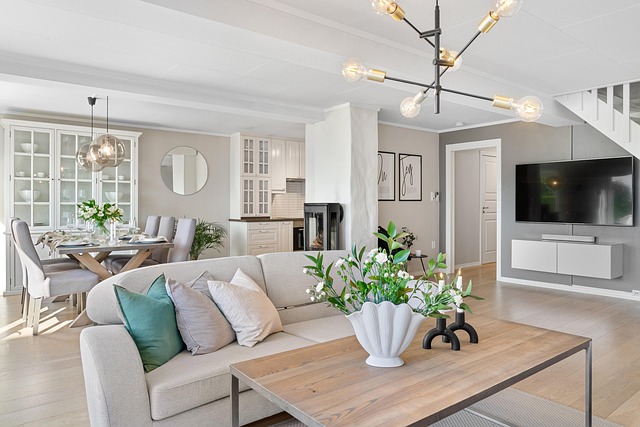Hardwood kitchen floors are not only aesthetically pleasing but also sustainable and durable, offering a long-lasting, eco-friendly option that can be responsibly sourced (with many species certified by the FSC). Modern alternatives like engineered wood floors and luxury vinyl tiles (LVT) provide similar benefits with reduced environmental impact. Proper maintenance is crucial for preserving these floors' beauty, and eco-friendly materials like bamboo and cork seamlessly integrate into contemporary kitchen designs, aligning with green living values.
“Elevate your modern kitchen with eco-friendly flooring that combines style and sustainability. In an era focused on environmental consciousness, choosing the right floor can make a significant impact. This article explores the allure of hardwood kitchen floors, their ecological alternatives, and expert tips for installation and maintenance. Discover how to seamlessly integrate sustainable style into your living space, blending natural beauty with responsible choices.”
- The Appeal of Hardwood Kitchen Floors: Natural Beauty Meets Sustainability
- Eco-Friendly Alternatives to Traditional Hardwood: Exploring Options
- Installation and Maintenance Tips for Longevity and Aesthetics
- Designing with Eco-Flooring: Modern Kitchens and Sustainable Style Integration
The Appeal of Hardwood Kitchen Floors: Natural Beauty Meets Sustainability
Hardwood kitchen floors have long been a popular choice among homeowners and designers alike, but their appeal goes beyond mere aesthetics. The natural beauty of hardwood brings warmth and character to any space, with its unique grain patterns and tonal variations adding depth and texture to modern kitchens. This timeless look ensures that hardwood flooring remains a sustainable and stylish option for those seeking to enhance their living environments.
Sustainability is a key consideration in today’s eco-conscious world, and hardwood kitchen floors tick all the boxes. Hardwood is a renewable resource when sourced responsibly, with many species being certified by organizations like the Forest Stewardship Council (FSC). Unlike some synthetic materials, hardwood flooring offers a long-lasting option that can be restored or reused, reducing waste and minimizing environmental impact. Its durability means it can withstand heavy foot traffic and the demands of a kitchen, making it a practical choice for modern lifestyles.
Eco-Friendly Alternatives to Traditional Hardwood: Exploring Options
In recent years, there’s been a growing demand for eco-friendly alternatives to traditional hardwood kitchen floors, reflecting a broader trend in home design that prioritizes sustainability and environmental impact. This shift is driven not only by consumers’ increasing awareness of ecological issues but also by manufacturers’ efforts to develop materials that are both durable and environmentally responsible. Among the options gaining popularity are engineered wood floors, which offer many of the same aesthetic benefits as hardwood but with a reduced environmental footprint. These floors are constructed using multiple layers of wood veneers, ensuring stability and longevity while minimizing the need for vast amounts of raw timber.
Another promising alternative is luxury vinyl tiles (LVT), known for their exceptional durability and versatility. LVT flooring simulates the look of hardwood through high-resolution images, providing a realistic aesthetic without the environmental concerns associated with real hardwood. Furthermore, LVT is highly resistant to scratches, stains, and moisture, making it an ideal choice for kitchens, where spills and water exposure are common. This eco-friendly option is not only sustainable but also offers excellent value, making it a compelling choice for modern homeowners looking to create beautiful, durable, and environmentally conscious kitchen spaces.
Installation and Maintenance Tips for Longevity and Aesthetics
When installing eco-friendly flooring in your modern kitchen, proper maintenance is key to preserving its longevity and aesthetic appeal. For example, hardwood kitchen floors require a balance of care. Regular cleaning with a microfiber mop or broom helps remove dirt and debris without damaging the surface. Avoid using harsh chemicals or abrasive cleaners which can strip away the finish. Additionally, keeping moisture levels in check is crucial; ensure spills are wiped up promptly to prevent water damage. Regular polishing or resealing every few years will restore the floor’s natural glow and protect it from wear and tear.
Designing with Eco-Flooring: Modern Kitchens and Sustainable Style Integration
In modern kitchens, eco-friendly flooring solutions not only contribute to a greener home but also seamlessly integrate with contemporary design aesthetics. When choosing sustainable flooring options like bamboo, cork, or recycled materials, homeowners can create a stylish and conscious space. These materials offer unique textures and visual appeals that complement the sleek lines and open layouts often seen in modern kitchen designs. For instance, hardwood kitchen floors made from responsibly sourced wood add warmth and character while aligning with eco-conscious values.
Designers can play around with various patterns and finishes to create visually stunning kitchens. Incorporating eco-flooring doesn’t mean sacrificing style; instead, it allows for a harmonious blend of form and function. From minimalist geometric patterns to rustic organic textures, these flooring options cater to diverse design preferences while promoting environmental sustainability.
Modern kitchens are not just about aesthetics; they’re also about sustainability. By opting for eco-friendly flooring solutions like bamboo, cork, or recycled materials, homeowners can enjoy the natural beauty of hardwood kitchen floors while minimizing their environmental impact. With proper installation and maintenance tips outlined in this article, you can ensure your eco-flooring lasts for years to come, seamlessly integrating sustainable style into your contemporary kitchen design.
